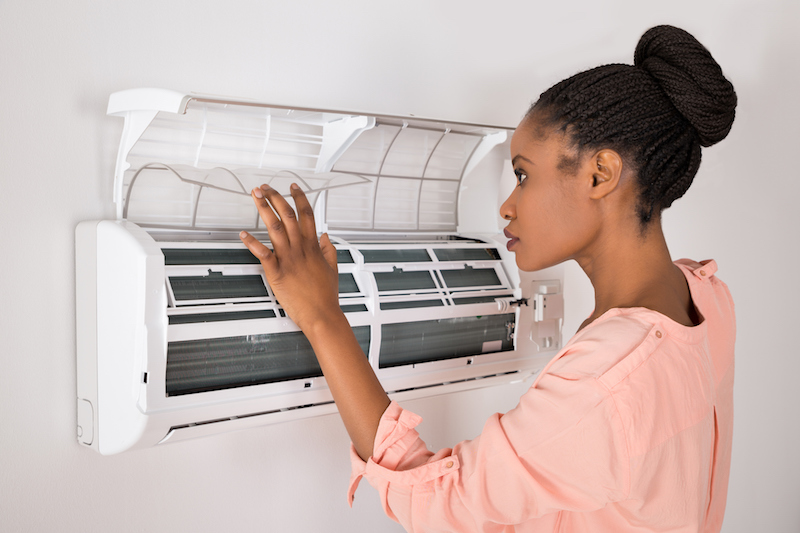
You shouldn’t need to compromise on comfort or drain your wallet to keep your house at a pleasant temp during warm days.
But what is the ideal setting, exactly? We discuss suggestions from energy pros so you can select the best setting for your family.
Here’s what we recommend for the most energy-efficient setting for air conditioning in Pocatello.
Recommended Thermostat Settings for Summer
Most people find using the thermostat at 72-73 degrees is most comfortable. However, if there’s a big difference between your inside and outside temps, your electrical costs will be greater.
This is our advice based on the U.S. Department of Energy (DOE) and ENERGY STAR®.
While at home: 78 degrees. While that seems warm, there are methods you can keep your home refreshing without having the air conditioning running all the time.
Keeping windows and window treatments closed during the day keeps cold air where it needs to be—within your home. Some window coverings, like honeycomb shades or plantation shutters, are made to provide added insulation and enhanced energy efficiency.
If you have ceiling fans in your home, the DOE says you can raise thermostat settings about 4 degrees warmer without giving up comfort. That’s due to the fact they cool with a windchill effect. Because they cool people, not spaces, switch them off when you exit a room.
If 78 degrees still feels too warm initially, try doing an experiment for approximately a week. Start by increasing your thermostat to 78 degrees while you’re home. Then, gradually decrease it while adhering to the suggestions above. You could be shocked at how cool you feel at a hotter temperature setting.
While away: 88 degrees. There’s no reason to keep the air conditioning working all day while your home is unoccupied. Moving the temperature 7–10 degrees warmer can save you an estimated 5–15% on your electricity bills, according to the DOE.
When you come home, don’t be tempted to set your thermostat colder than 78 to cool your residence more quickly. This isn’t useful and usually leads to a higher AC bill.
A programmable thermostat is a helpful approach to keep your settings controlled, but you need to set programs. If you don’t utilize programs, you risk forgetting to increase the set temperature when you take off.
If you’re looking for a hassle-free fix, think over buying a smart thermostat. This thermostat links with your phone, so it knows when you’re at your residence and when you’re out. Then it intuitively changes temperature settings for maximum savings. How much exactly? Usually $180 annually on heating and cooling, according to ENERGY STAR.
Another benefit of installing a smart thermostat? You can use your phone to watch and regulate temperature settings from just about anywhere.
While sleeping: Around 70 degrees. While ENERGY STAR suggests 82 degrees, that may be unbearable for most families. The majority of people sleep better when their sleeping space is chilled, so that’s why the National Sleep Foundation advises 60–67 degrees. But that might be too cold, depending on your clothing and blanket preference.
We recommend following a similar test over a week, setting your thermostat higher and steadily turning it down to find the right temp for your residence. On pleasant nights, you might find keeping windows open at night and running a ceiling fan is a better option than operating the AC.
More Approaches to Save Energy During Warm Weather
There are additional ways you can save money on AC bills throughout hot weather.
- Buy an energy-efficient AC system. Central air conditioners only work for about 12–15 years and become less efficient as they get older. A new air conditioner can keep your house cooler while keeping AC bills down.
- Schedule yearly air conditioner maintenance. Routine air conditioner maintenance keeps your equipment operating like it should and may help it work more efficiently. It can also help extend its life span, since it enables technicians to find seemingly insignificant problems before they create a major meltdown.
- Replace air filters frequently. Follow manufacturer instructions for replacing your air filter. A dirty filter can lead to your system short cycling, or switch on and off too much, and raise your energy.
- Inspect attic insulation levels. Nearly 90% of residences in the United States don’t have proper insulation, according to the Insulation Institute. Many southern climates should have 13–14” of attic insulation, while northern climates need 16–18”.
- Have your ductwork checked. Ductwork that has come apart over time can seep cold air into your attic, walls or crawl space. This can result in major comfort issues in your house, such as hot and cold spots.
- Seal cracks, doors and windows. Keep hot air in its place by plugging openings. You can also caulk or weather strip doors to seal more cold air within your home.
Use Less Energy This Summer with Vogts Heating & Air
If you want to conserve more energy during hot weather, our Vogts Heating & Air pros can help. Reach us at 208-621-0129 or contact us online for more information about our energy-saving cooling solutions.
